Ethnomedicinal Plants Used in the Health Care System: Survey of the Mid Hills of Solan District, Himachal Pradesh, India
- PMID: 34579373
- PMCID: PMC8467016
- DOI: 10.3390/plants10091842
Ethnomedicinal Plants Used in the Health Care System: Survey of the Mid Hills of Solan District, Himachal Pradesh, India
Abstract
The study was performed in the mid hills of the Dharampur region in Solan district of Himachal Pradesh, India. At the study site, a total of 115 medicinal plants were documented (38 trees, 37 herbs, 34 shrubs, 5 climbers, 1 fern, and 1 grass). In the study region, extensive field surveys were performed between March 2020 and August 2021. Indigenous knowledge of wild medicinal plants was collected through questionnaires, discussions, and personal interviews during field trips. Plants with their correct nomenclature were arranged by botanical name, family, common name, habitat, parts used, routes used, and diseases treated. In the present study, the predominant family was Rosaceae, which represented the maximum number of plant species, 10, followed by Asteraceae and Lamiaceae, which represented 8 plant species. The rural inhabitants of the Dharampur region in the Solan district have been using local plants for primary health care and the treatment of various diseases for a longer time. However, information related to the traditional knowledge of medicinal plants was not documented. The rural inhabitants of the Dharampur region reported that the new generation is not so interested in traditional knowledge of medicinal plants due to modernization in society, so there is an urgent need to document ethnomedicinal plants before such knowledge becomes inaccessible and extinct.
Keywords: ethnobotany; rural inhabitant; traditional medicine; use value.
Conflict of interest statement
The authors declare no conflict of interest.
Figures






References
-
- WHO Report . WHO Global Report on Traditional and Complementary Medicine 2019. World Health Organization; Geneva, Switzerland: 2019. pp. 1–228.
-
- World Health Organization (WHO) WHO Traditional Medicine Strategy 2014–2023. World Health Organization; Geneva, Switzerland: 2013. pp. 1–76.
-
- Mahmood A., Mahmood A., Tabassum A. Ethnomedicinal Survey of Plants from District Sialkot, Pakistan. J. Appl. Pharm. 2011;3:212–220. doi: 10.21065/19204159.3.212. - DOI
LinkOut - more resources
Full Text Sources

